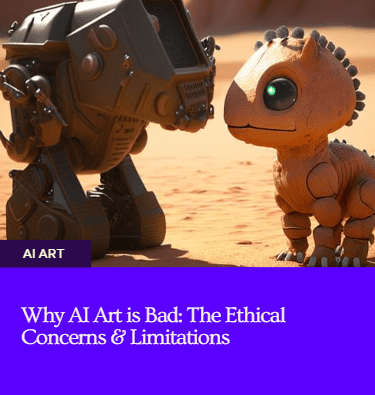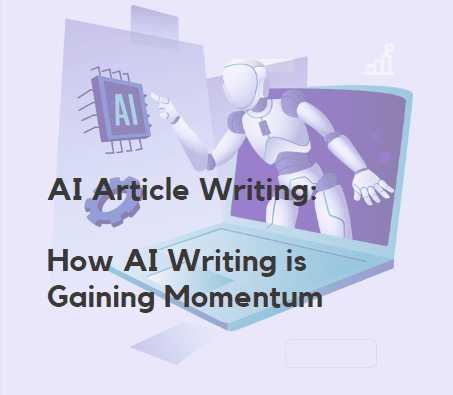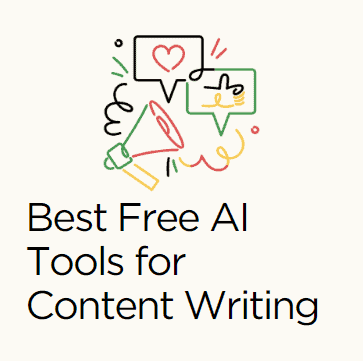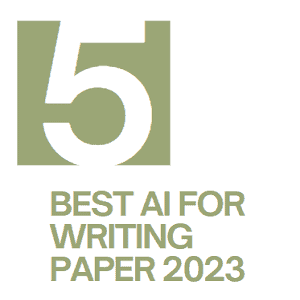Why AI Art is Bad: The Ethical Concerns & Limitations

Do you think AI art is bad?
Do you love the many apps out there helping you get AI generated photos, or logos?
In this article we delve into Why AI Art is bad and the effects it has in the creativity industry. We believe it still has a place in the creativity industry but needs to be regulated.
Since the inception of artificial intelligence, there has been a continuous push of boundaries regarding human creativity. As a result, there has been a controversial trend of AI digital art capturing human attention compared to that developed by human beings. Of course, we all saw this as a fascinating tech advancement that would help open up new possibilities for designers. Still, as time passes, we slowly realize that it comes with many ethical concerns and limitations.
Here are some limitations of AI art and why we think it can be problematic. We will also check the potential consequences we may experience in the art industry as we answer Why AI Art is Bad!.
Why AI Art is Bad; The Limitations
There is no originality.
Any art designed by AI always raises questions concerning its authenticity and the originality of the creative. The primary reason for such occurrences is that training AI algorithms uses already existing art pieces, meaning that whatever it generates usually imitates an already existing one.
Obviously, any art generated by AI is always very appealing to the eyes. Still, it lacks the unique and creative expression a human artist would have developed. Therefore, a more emotional and personal touch is needed, like in other human art forms.
AI art brings about ownership issues.
We have already learnt that AI art comes from imitating an already existing skill. Hence, most artworks may unintentionally replicate a copyrighted design without permission.
If such a case happens, the assessors will have difficulty telling who owns the rights to the piece. This will also raise questions on whether human artists who creatively developed the artwork are compensated adequately for their hard work.
Depreciation of human creativity
Employers are no longer hiring, and it has become a threat that AI may soon replace our creative human artists.
We should, therefore, expect extensive effects in the industry that will lead to a decrease in the appreciation of human talents and financial challenges from lack of employment.
There is little to human touch in AI-generated art
An emotional depth comes with human-generated artwork that results in a particular connection. Expectations are that the person who developed the craft was doing it to express emotions.
However, no matter how visually striking AI Images appear, nothing is close to what a human being could have conveyed. These pieces feel more superficial since the AI algorithms cannot understand or interpret human experiences.
There is a fear of privacy intrusion.
Human beings are often required to input their data, personal information or even photos so that the AI generators can create customized content. Still, they need to find out whether their information is secure.

Such cases have happened before, and we expect that these AI art platforms will prioritize data protection and assure users that their information is safe. Users should also be allowed to have complete control over such kind of information.
Biasness is another reason Why AI Art is Bad
We know that AI algorithms may not understand human feelings and experiences. Therefore, when developing content, they can unintentionally amplify biases, be it gender, culture, or even race.
A negative impact on human creativity
Human beings will relax due to the over-dependence on AI in any artistic creation. It is actually not only on art, but AI has made people undermine the struggles and growth resulting from human creativity.
Erosion of skill mastery
Have you ever noticed that once you stay for a long practising a skill that took you almost your entire life to learn, you’ll still forget some critical aspects? The same case will apply to human art creation since AI might diminish the value of these skills, and there will be nowhere that human craftsmanship will be needed.
Also, a human’s dependence on AI for ideas will lower his or her critical thinking ability, and over time, it will be challenging to innovate independently.
Cultural traditions will be lost.
As discussed earlier, AI has no human touch, so it may be difficult to know the different cultural art forms available. Hence, diverse artistic traditions will be lost.
The art market may go down.
Since there is no proof of authenticity in different artworks in the market, people may not value AI-generated end products.

The results of AI are unpredictable.
Once you feed information to the AI, it is not certain whether the information you get is correct or an exact match of what you wanted.
Sometimes, you will get offensive results; some will be a lot of nonsense, while others are illogical.
FAQ
Is AI art creative enough to replace human creativity?
No. Any AI-generated art comes about from algorithms which mimic human-generated artwork.
Can AI art reduce the value of the human creative process?
AI accessibility is a double-edged sword at the moment. There is, however, an argument that it might diminish the value of skills and craftsmanship that human artists portray in their work.
Can we maintain authenticity in AI-generated art?
This is almost next to impossible to authenticate AI art due to its digital nature.
Is it possible for AI art to inspire emotional responses similar to those of human-generated art?
We can never compare the emotional connection between human-generated art and the viewer’s perception to that generated by AI. The reason is that human-created art is always unique, no matter how often it reappears. AI art needs this kind of depth.
Conclusion
While AI art comes with its ethical concerns and limitations, it is essential to remember that it has many advantages. Therefore, this article should not paint a negative picture in any person’s mind concerning AI since we were looking at the limitations brought about by it. We should embrace both the good and dark sides of AI. Still, the dark side must remind us to tread carefully regarding art integrity, cultural diversity and human creativity.
It is, therefore, our duty to ensure that all AI-generated art is used responsibly and in ways that the originality and integrity of human art are respected.






